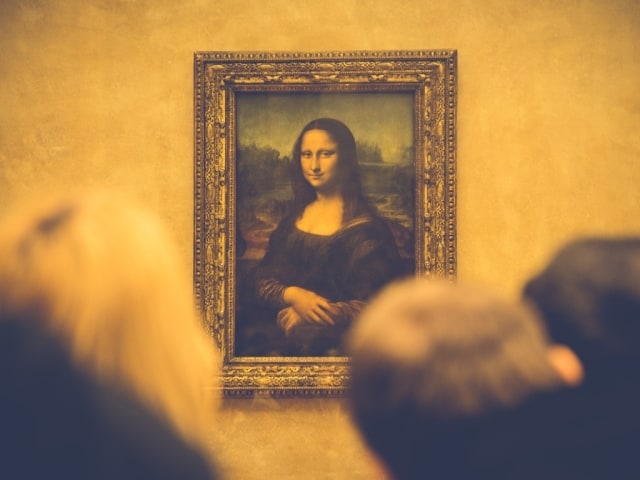10 Famous Artworks from Leonardo da Vinci
Leonardo da Vinci may be one of the most famous artists in the world. Even if you have zero interest in the art world, you’ve probably heard of his name! And, if you’ve traveled throughout Europe, you’ve probably stumbled upon some of his work. You’ll find several of his paintings in museums in Paris, Rome, and Florence.
Da Vinci produced at least 15 works of art in his lifetime. If you don’t know where to start, here are 10 famous artworks from Leonardo da Vinci!
1. Mona Lisa (circa 1503-19)
Not only is the Mona Lisa one of da Vinci’s most famous paintings, but it’s also one of the most famous paintings in the world! The first time you see it, you may wonder why this small (it’s only 77 cm x 53 cm) painting is so famous. Art historians say that the Mona Lisa skyrocketed to fame because it’s a prime example of da Vinci’s mastery for realism and his use of light and shadows. The latter technique is called sfumato.
Try making eye contact with the painting and then move across the room. You’ll notice that Mona’s eyes follow you wherever you go!
Where to see it: The Louvre Museum, Paris, France
2. The Last Supper (circa 1495-98)
Another world-famous painting by da Vinci is, of course, The Last Supper. This painting portrays several scenes from the Christian Bible, specifically the moment when Jesus tells his Apostles that one of them will betray him. It also depicts the first time that Jesus introduced the Eucharist, a Christian ceremony in which bread and wine are blessed and then consumed.
The Last Supper is admired due to the variety of emotions that da Vinci was able to convey on each person’s face.
Where to see it: The Santa Maria Delle Grazie Monastery, Milan, Italy
3. Vitruvian Man (circa 1490)
Da Vinci kept notebooks throughout his adult life, and these journals have become a real treasure trove of information. Vitruvian Man represents the ideal proportions of a man as presented by the ancient Roman architect Vitruvius. Vitruvius had a theory that the ideal human would be able to fit within a circle and a square. Da Vinci went on to prove his theory to be true through his Vitruvian Man drawing through the use of math, philosophy, and art.
Where to see it: Gallerie dell’Accademia, Venice, Italy
4. Portrait of Ginevra de’ Benci (circa 1474/78)
This is one of da Vinci’s earliest paintings. Portrait of Ginevra de’ Benci is one of the first instances in Italian art history in which the subject of a portrait is shown in a three-quarter pose rather than a profile. Da Vinci was likely inspired by artists in the north that were already known to use this pose. The three-quarter pose soon became the standard for portraits across the world.
Where to see it: The National Gallery of Art, Washington, D.C., United States
5. Virgin of the Rocks (circa 1483–86)
There are actually two almost identical versions of the Virgin of the Rocks by da Vinci. The one above is the first and more famous version. Why would da Vinci paint the same painting twice?! Well, the artist was involved in several disputes with a group called the Confraternity of the Immaculate Conception. The confraternity commissioned the first piece and when the pair ended up on bad terms, da Vinci produced another painting over 20 years later in 1508. The second painting is on display in the National Gallery of London.
Where to see it: The Louvre Museum, Paris, France
6. Lady With an Ermine (circa 1489–91)
Scholars assume that the woman depicted in Lady With an Ermine is the mistress of da Vinci’s patron, the Duke of Milan. Ermines were traditionally used as the emblem for the duke and he was known to have a mistress named Cecilia Gallerani. This painting is another great example of da Vinci’s mastery of realism. The woman’s hand as well as the ermine’s head are beautifully realistic.
Where to see it: The National Museum, Kraków, Poland
7. Self Portrait (circa 1490/1515–16)
This painting is sometimes called Portrait of a Man in Red Chalk, but it is largely considered to be a self-portrait. However, some historians argue that the man in the chalk drawing is too old to be da Vinci himself, as he died at age 67. These scholars suggest that this drawing is one of his “grotesque” pieces or his depictions of people with exaggerated features.
Whoever it represents, this drawing is a great example of da Vinci’s ability to instill lifelike characterizes into his subjects.
Where to see it: The Royal Library, Turin, Italy
8. Head of a Woman (circa 1500–10)
The woman pictured in Head of a Woman looks very similar to the depiction of the Virgin Mary in Virgin of the Rocks, prompting several art historians to assume that it served as a model, or practice round, for the larger work of art. The drawing is sometimes called La scapigliata, which translates to “disheveled,” and refers to her loose hairstyle.
Where to see it: The National Gallery, Parma, Italy
9. Salvator Mundi (circa 1500)
Salvator Mundi is perhaps the most controversial painting on my list! When it sold for a whopping $450.3 million at an auction in 2017, many questioned whether the painting could be credited to da Vinci. It was in terrible condition, and several art historians stated that the style in which Jesus’ face was painted could not belong to da Vinci.
However, other art historians insist that it is da Vinci’s work and Jesus’ warped representation is due to botched restorations over the years.
Where to see it: this painting is owned by the Crowned Prince of Saudi Arabia and is not currently housed in a museum.
10. The Virgin and Child with Saint Anne (circa 1503–19)
Art historians believe that The Virgin and Child with Saint Anne was da Vinci’s final painting before he died in 1519. The painting depicts three generations of the Holy Family: Saint Anne, the Virgin Mary’s mother, Mary, and Jesus. The painting also showcases da Vinci’s passion for creating three-dimensional figures on a two-dimensional surface.
Where to see it: The Louvre Museum, Paris, France
Conclusion
If you’re interested in learning more about da Vinci’s most famous artworks and are looking for a place to start, this list should be helpful! Leonardo da Vinci was a master and his legacy lives on nearly five centuries after his death.
Planning a trip to Paris ? Get ready !
These are Amazon’s best-selling travel products that you may need for coming to Paris.
Bookstore
- The best travel book : Rick Steves – Paris 2023 – Learn more here
- Fodor’s Paris 2024 – Learn more here
Travel Gear
- Venture Pal Lightweight Backpack – Learn more here
- Samsonite Winfield 2 28″ Luggage – Learn more here
- Swig Savvy’s Stainless Steel Insulated Water Bottle – Learn more here
Check Amazon’s best-seller list for the most popular travel accessories. We sometimes read this list just to find out what new travel products people are buying.




















